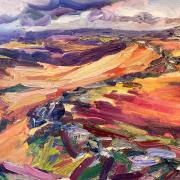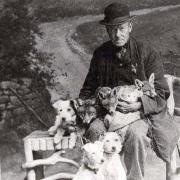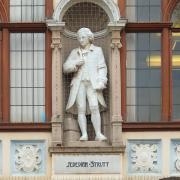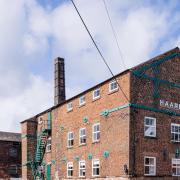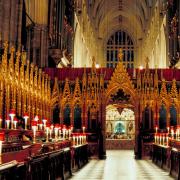The man inspired by Derbyshire to found the American textile industry.
In the spring of 1783, Kirk Boott, a 33-year-old Derby man, left England to begin a new life in America. It was the start of a remarkable journey that would ultimately have a profound effect upon the industrialisation of the United States, much of it inspired by events in Derbyshire.Boott, whose parents, Francis and Elizabeth, had run a market garden and greengrocery in Derby before his father's premature death in 1776, eventually settled in the fledgling city of Boston, Massachusetts, where he determined to establish himself as a successful merchant by selling seeds and hardware goods. Within weeks of his arrival, however, it was clear that almost every other immigrant was trying to achieve the same goal. Even to survive in his new homeland, Boott realised that hard work alone would not be enough; he would also have to summon all his entrepreneurial skills.After re-examining the market, Boott sent to England for clothing and household wares. At last his business began to thrive. By November 1783, he opened a shop which was soon patronised by some of the most influential people in Boston, among them Revolutionary War hero, Paul Revere.Boott's wife Mary, whom he had met on his journey to America, had already established a successful millinery business in Boston, and the couple were able to build a large mansion in an affluent area of the city, where they raised their nine children. Three of their sons established and maintained a strong connection with England, and with Derbyshire in particular. Francis, born in Boston in 1792, graduated from Harvard in 1810 and the following year made the long journey to his father's old hometown. He had intended becoming a merchant in London but remained in Derby for the next three years where, according to family records he 'formed both the scientific and social attachments which determined the aims ... of his whole after life.'By the time he returned to Boston in 1814, Francis had become a keen botanist and began collecting native plants from all over New England. In 1820, he decided to make a permanent home in England and studied medicine in London and Edinburgh, after which he became a distinguished doctor. His brothers, John and Kirk junior (born 1790), were sent to England to be educated at Rugby School. Both boys paid regular visits to their aunt in Derby, and Kirk junior, in particular, formed a lifelong affection for his father's hometown. The young Kirk also attended Harvard, although did not graduate and, like Francis, returned to live in Derby for several years. There he met Ann Haden who, as a young girl, had been painted by Joseph Wright. Kirk junior and Ann were married in 1818 at St Michael's Church, Derby. When news came of Kirk senior's death, the newlyweds returned at once to Boston.But young Kirk was not content to simply continue the family business. While in Derby he had been inspired by both the business methods and philanthropy of the Strutt family, the town's leading industrialists, and could see endless investment possibilities for his American home state. He set out a proposal to establish a cotton manufacturing business on the banks of the Merrimack River in central Massachusetts.He began to acquire land from local farmers who remained unaware of his intentions. There was controversy when it became apparent that Boott needed the land and access to the river in order to power his massive mill complex. One local amateur poet marked the occasion thus, 'There came a young man from the old countree, the Merrimack River he happened to see, What a capital place for mills quoth he, ... And then these farmers so cute, They gave all their lands and timber to Boott.'With the assistance of William Strutt, who helped design the mills and machinery, Boott oversaw the entire project. It was of enormous significance because it was to be the first large-scale industrial planning development on the North American continent.Boott had petitioned to name the new settlement after his beloved English home. But the other investors preferred to honour one of their most eminent fellow directors, and so the town was named Lowell, after wealthy benefactor, Francis Cabot Lowell. Boott did manage to give his new home a taste of Derby - the mills and mill cottages were very like those of the English town, and Boott saw that the design for the Episcopal St Ann's Church bore more than a passing resemblance to St Michael's in Derby.The mills, and their neat, tidy workers' cottages, were very like those in Derby and, within decades, the settlement of Lowell had grown to impressive size. From its incorporation as a town in 1826 with a population of just 2,500, by 1830 it boasted 6,477 inhabitants, and by 1836 a remarkable 17,633. Lowell also became something of a tourist attraction. In 1833, US President Andrew Jackson visited the town, and the following year several noted celebrities, among them Davy Crockett and Daniel Webster, toured Lowell. From across the Merrimack River, visitors came to stare at the line of five and six-storey brick mills that clutched the riverbank for close to a mile. Those same visitors were drawn into the town to see some six miles of canals that coursed through the city and provided power for around 40 mill buildings that employed more than 10,000 workers. So impressive had Lowell become that poet John Greenleaf Whittier noted that it was 'a city springing up like the enchanted palaces of the Arabian Tales, as it were in a single night - stretching far and wide its chaos of brick masonry.'Today, the original mills and mill cottages form the Boott Cotton Mills Museum, a part of the Lowell National Historical Park, and remain one of the most visited tourist attractions in Massachusetts.So great was Boott's domination of daily life in Lowell that some residents feared he wielded too much influence on their affairs. Indeed, there seemed to be few institutions in which Boott did not have a controlling interest. He was a director of almost every corporation in town, from the Boston & Lowell Railroad and the Lowell Bank, to the Lowell Brewery and the Lowell Fire Department. Boott was also noted for his stubbornness. When he lost an argument with the vicar of St Ann's, he simply began worshipping at another church; when there was a labour dispute at his mills, Boott stood firm; and when, one Fourth of July, he hoisted the Union Flag above the Stars and Stripes over his house, despite protestations he refused to remove it - in the end an angry mob did the job for him.For the most part, however, Kirk Boott junior, like his father before him, was respected as a fair-minded, well-mannered and much loved member of society. He was certainly greatly mourned when he was killed as his carriage overturned on a street corner in 1837. And thanks to him, a little bit of Derbyshire influence can still be seen in a small corner of America.





